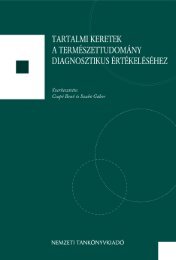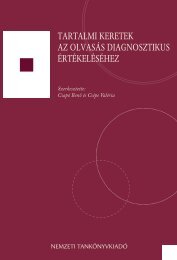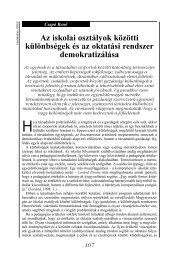értekezés - Neveléstudományi Intézet - Szegedi Tudományegyetem
értekezés - Neveléstudományi Intézet - Szegedi Tudományegyetem
értekezés - Neveléstudományi Intézet - Szegedi Tudományegyetem
Create successful ePaper yourself
Turn your PDF publications into a flip-book with our unique Google optimized e-Paper software.
IRODALOM<br />
Adamikné Jászó Anna (2004): 33 téma a szövegértı olvasás fejlesztésére. Holnap Kiadó Kft.,<br />
Budapest.<br />
Adamikné Jászó Anna (2006): Az olvasás múltja és jelene. Trezor Kiadó, Budapest.<br />
Allen, L. S. és Gorski, R. A. (1991): Sexual dimorphism of the anterior commissure and<br />
massa intermedia of the human brain. Journal of Comparative Neurology, 312. 97–104.<br />
Altenmüller, E. és Gruhn, W. (2002): Brain mechanism. In: Parncutt, R. és McPherson, G. E.<br />
(szerk.): The Science and Psychology of Music Performance. Oxford University Press,<br />
New York. 63–82.<br />
Altenmüller, E. és Gruhn, W. (1997): Music, the Brain, and Music Learning. GIA, Chicago.<br />
Altenmüller, E. és Gruhn, W. (2002): Brain mechanism. In: Parncutt, R. és McPherson, G. E.<br />
(szerk.): The Science and Psychology of Music Performance. Oxford University Press,<br />
New York. 63–82.<br />
Amunts, K., Schlaug, G., Jäncke, L., Steinmetz, A., Dabringhaus, A.. és Zilles, K. (1997):<br />
Motor cortex and hand motor skills: Structural compliance in the human brain. Human<br />
Brain Mapping, 5. 3. sz. 206–215.<br />
Andrade, P. E. és Bhattacharya, J. (2003): Brain turned to music. Journal of the Royal Society<br />
of Medicine, 96. 284–287.<br />
Andrews, P., Diego-Mantecon, J. Vankus, P., Eynde, P. O. és Conway, P. (2008): A tanulók<br />
matematikai meggyızıdéseinek értékelése: Egy három országot érintı összahasonlító<br />
vizsgálat. Iskolakultúra Online, 2. sz. 141–159.<br />
Anvari, S. H., Trainor, L. J., Woodside, J. és Levy, B. A. (2002): Relations among musical<br />
skills, phonological processing, and early reading ability in preschool children.<br />
Experimental Child Psychology, 83. 111–130.<br />
Atherton, M. (2007): A proposed theory of the neurological limitations of cognitive transfer.<br />
Paper presented at the annual meeting of the American Educational Research Association,<br />
Chicago, IL. 1–8.<br />
Atterbury, M. J. (1984): Music teachers need your help. Journal of Learning Disabilities, 17.<br />
2. sz. 75–77.<br />
Atterbury, M. J. (1985): Musical differences in learning-disabled and normal-achieving<br />
readers aged seven, eight and nine. Psychology of Music, 13. 114–123.<br />
Babo, G. B. (2004): The relationship between instrumental music participation and standardized<br />
assessment achievement of middle school students. Research Studies in Music<br />
Education, 22. 14–26.<br />
Bailey, P. J., és Snowling, M. J. (2002): Auditory processing and the development of<br />
language and literacy. British Medical Bulletin, 63. 135–146.<br />
Balázsi Ildikó és Balkányi Péter (2008): A negyedik osztályosok szövegértése. Új Pedagógiai<br />
Szemle, 58. 1. sz. 3–11.<br />
Balogh László (2006): Pedagógiai pszichológia az iskolai gyakorlatban. Urbis Könyvkiadó,<br />
Budapest.<br />
Bamberger, J. (1991): The Mind behind the Musical Ear. Harvard University Press, Cambridge.<br />
Bamberger, J. (1996): Turning music theory on its ear: Do we hear what we see: do we see<br />
what we say? International Journal of Computers and Mathematics Education. 1. 33–55.<br />
280



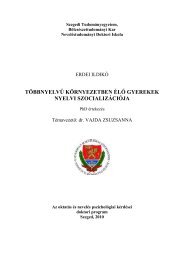

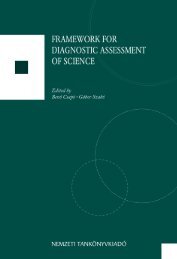
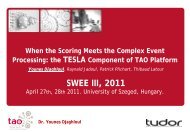
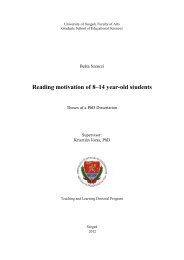

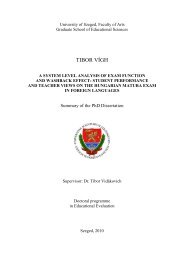
![Download [PDF] - Diagnosztikus Mérések Fejlesztése](https://img.yumpu.com/38928685/1/177x260/download-pdf-diagnosztikus-macracsek-fejlesztacse.jpg?quality=85)
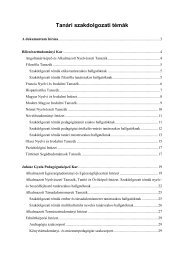


![Download [PDF] - Diagnosztikus Mérések Fejlesztése](https://img.yumpu.com/38928622/1/180x260/download-pdf-diagnosztikus-macracsek-fejlesztacse.jpg?quality=85)
